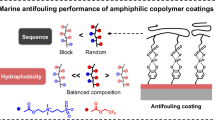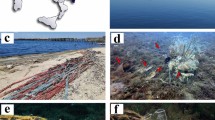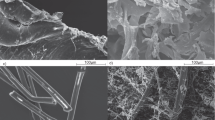Abstract
The anti-fouling character of polymer brushes against marine organisms was investigated by performing settlement tests with barnacle cypris larvae and mussel larvae in their adhesion period, as well as a marine bacteria colonization test. The settlement behavior of the marine organisms was carefully observed during the assays to obtain insight into the anti-fouling character. Zwitterionic poly(phosphobetaine) brushes and poly(sulfobetaine) brushes exhibited excellent anti-fouling characteristics for both macro- and micro-organisms, whereas poly(quaternary ammonium cation) brushes allowed mussel larvae settlement and bacteria adhesion. Regardless of the surface free energy and chain mobility, all of the hydrophobic polymer brushes showed poor anti-fouling character for the marine organisms tested. The surface charge and hydration state in saline seawater appear to be important factors in the versatile anti-fouling performance of zwitterionic polyelectrolyte brushes.
Similar content being viewed by others
Log in or create a free account to read this content
Gain free access to this article, as well as selected content from this journal and more on nature.com
or
References
Yebra, D. M., Kiil, S. & Dam-Johansen, K. Antifouling technology-past, present and future steps towards efficient and environmentally friendly antifouling coatings. Prog. Org. Coat. 50, 75–104 (2004).
Lejars, M., Margaillan, A. & Bressy, C. Fouling release coatings: A nontoxic alternative to biocidal antifouling coatings. Chem. Rev. 112, 4347–4390 (2012).
Callow, J. A. & Callow, M. E. Trends in the development of environmentally friendly fouling-resistant marine coatings. Nat. Commun. 2, 244–254 (2011).
Brady, R. F. A fracture mechanical analysis of fouling release from nontoxic antifouling coatings. Prog. Org. Coat. 43, 188–192 (2001).
Schumacher, J. F., Carman, M. L., Estes, T. G., Feinberg, A. W., Wilson, L. H., Callow, M. E., Callow, J. A., Finlay, J. A. & Brennan, A. B. Engineered antifouling microtopographies – effect of feature size, geometry, and roughness on settlement of zoospores of the green alga Ulva. Biofouling 23, 55–62 (2007).
Liu, X., Zhou, J., Xue, Z., Gao, J., Meng, J., Wang, S. & Jiang, L. Clam's shell inspired high-energy inorganic coatings with underwater low adhesive superoleophobicity. Adv. Mater. 24, 3401–3405 (2012).
Xie, L., Hong, F., He, C., Ma, C., Liu, J., Zhang, G. & Wu, C. Coatings with a self-generating hydrogel surface for antifouling. Polymer 52, 3738–3744 (2011).
Bhushan, B. Bioinspired structured surfaces. Langmuir 28, 1698–1714 (2012).
Chen, S., Zheng, J., Li, L. & Jiang, S. Strong resistance of phosphorylcholine self-assembled monolayers to protein adsorption: Insights into nonfouling properties of zwitterionic materials. J. Am. Chem. Soc. 127, 14473–14478 (2005).
Ohkubo, Y., Kusu, K., Onishi, S. & Ogawa, K. The anti-biofouling effect against barnacles of a super-hydrophilic and high-oleophobic surface of treated aluminium. Sessile Organism 29, 41–48 (2012).
Ostuni, E., Chapman, R. G., Liang, M. N., Meluleni, G., Pier, G., Ingber, D. E. & Whitesides, G. M. Self-assembled monolayers that resist the adsorption of proteins and the adhesion of bacterial and mammalian cells. Langmuir 17, 6336–6343 (2001).
Jeon, S. I., Lee, J. H., Andrade, J. D. & Degennes, P. G. Protein surface interactions in the presence of polyethylene oxide. 1. simplified theory. J. Colloid Interface Sci. 142, 149–158 (1991).
Hester, J. F., Banerjee, P. & Mayes, A. M. Preparation of protein-resistant surfaces on poly(vinylidene fluoride) membranes via surface segregation. Macromolecules 32, 1643–1650 (1999).
Wagner, V. E., Koberstein, J. T. & Bryers, J. D. Protein and bacterial fouling characteristics of peptide and antibody decorated surfaces of PEG-poly(acrylic acid) co-polymers. Biomaterials 25, 2247–2263 (2004).
Schilp, S., Rosenhahn, A., Pettitt, M. E., Bowen, J., Callow, M. E., Callow, J. A. & Grunze, M. Physicochemical properties of (ethylene glycol)-containing self-assembled monolayers relevant for protein and algal cell resistance. Langmuir 25, 10077–10082 (2009).
Jiang, S. & Cao, Z. Ultralow-fouling, functionalizable, and hydrolyzable zwitterionic materials and their derivatives for biological applications. Adv. Mater. 22, 920–932 (2010).
Yang, W. J., Neoh, K.-G., Kang, E.-T., Teo, S. L.-M. & Rittschof, D. Polymer brush coatings for combating marine biofouling. Prog. Polym. Sci. 39, 1017–1042 (2014).
Zhang, Z., Chen, S., Chang, Y. & Jiang, S. Surface grafted sulfobetaine polymers via atom transfer radical polymerization as superlow fouling coatings. J. Phys. Chem. B 110, 10799–10804 (2006).
Cheng, G., Zhang, Z., Chen, S., Bryers, J. D. & Jiang, S. Inhibition of bacterial adhesion and biofilm formation on zwitterionic surfaces. Biomaterials 28, 4192–4199 (2007).
Zhang, Z., Finlay, J. A., Wang, L., Gao, Y., Callow, J. A., Callow, M. E. & Jiang, S. Polysulfobetaine-grafted surfaces as environmentally benign ultralow fouling marine coatings. Langmuir 25, 13516–13521 (2009).
Aldred, N., Li, G., Gao, Y., Clare, A. S. & Jiang, S. Modulation of barnacle (Balanus amphitrite Darwin) cyprid settlement behavior by sulfobetaine and carboxybetaine methacrylate polymer coatings. Biofouling 26, 673–683 (2010).
Kitano, H., Kondo, T., Kamada, T., Iwanaga, S., Nakamura, M. & Ohno, K. Anti-biofouling properties of an amphoteric polymer brush constructed on a glass substrate. Colloids Surf B Biointerfaces 88, 455–462 (2011).
Ishihara, K., Nomura, H., Mihara, T., Kurita, K., Iwasaki, Y. & Nakabayashi, N. Why do phospholipid polymers reduce protein adsorption? J. Biomed. Mater. Res. 39, 323–330 (1998).
Feng, W., Zhu, S., Ishihara, K. & Brash, J. L. Adsorption of fibrinogen and lysozyme on silicon grafted with poly(2-methacryloyloxyethyl phosphorylcholine) via surface-initiated atom transfer radical polymerization. Langmuir 21, 5980–5987 (2005).
Iwata, R., Suk-In, P., Hoven, V. P., Takahara, A., Akiyoshi, K. & Iwasaki, Y. Control of nanobiointerfaces generated from well-defined biomimetic polymer brushes for protein and cell manipulations. Biomacromolecules 5, 2308–2314 (2004).
Zhao, B. & Brittain, W. J. Polymer brushes: surface-immobilized macromolecules. Prog. Polym. Sci. 25, 677–710 (2000).
Quintana, R., Jańczewski, D., Vasantha, V. A., Jana, S., Lee, S. S. C., Parra-Velandia, F. J., Guo, S., Parthiban, A., Teo, S. L.-M. & Vancso, G. J. Sulfobetaine-based polymer brushes in marine environment: Is there an effect of the polymerizable group on the antifouling performance? Colloids Surf B Biointerfaces 120, 118–124 (2014).
Tsujii, Y., Ohno, K., Yamamoto, S., Goto, A. & Fukuda, T. Structure and properties of high-density polymer brushes prepared by surface-initiated living radical polymerization. Adv. Polym. Sci. 63, 1–45 (2006).
Kobayashi, M., Terayama, Y., Hosaka, N., Kaido, M., Suzuki, A., Yamada, N. L., Torikai, N., Ishihara, K. & Takahara, A. Friction behavior of high-density poly(2-methacryloyloxyethyl phosphorylcholine) brush in aqueous media. Soft Matter 3, 740–746 (2007).
Kobayashi, M., Terayama, Y., Yamaguchi, H., Terada, M., Murakami, D., Ishihara, K. & Takahara, A. Wettability and antifouling behavior on the surfaces of superhydrophilic polymer brushes. Langmuir 28, 7212–7222 (2012).
Kobayashi, M., Terayama, Y., Kikuchi, M. & Takahara, A. Chain dimensions and surface characterization of superhydrophilic polymer brushes with zwitterion side groups. Soft Matter 9, 5138–5148 (2013).
Kikuchi, M., Terayama, Y., Ishikawa, T., Hoshino, T., Kobayashi, M., Ogawa, H., Masunaga, H., Koike, J., Horigome, M., Ishihara, K. & Takahara, A. Chain dimension of polyampholytes in solution and immobilized brush states. Polym. J. 44, 121–130 (2012).
Kobayashi, M., Ishihara, K. & Takahara, A. Neutron reflectivity study of the swollen structure of polyzwitterion and polyeletrolyte brushes in aqueous solution. J. Biomater. Sci. Polym. Ed. 25, 1673–1686 (2014).
Zhulina, E. B. & Rubinstein, M. Ionic strength dependence of polyelectrolyte brush thickness. Soft Matter 8, 9376–9383 (2012).
Dunlop, I. E., Thomas, R. K., Titmus, S., Osborne, V., Edmondson, S., Huck, W. T. S. & Klein, J. Structure and collapse of a surface-grown strong polyelectrolyte brush on sapphire. Langmuir 28, 3187–3193 (2012).
Murakami, D., Takenaka, A., Kobayashi, M., Jinnai, H. & Takahara, A. Measurement of the electrostatic interaction between polyelectrolyte brush surfaces by optical tweezers. Langmuir 29, 16093–16097 (2013).
Kobayashi, M., Tanaka, H., Minn, M., Sugimura, J. & Takahara, A. Interferometry study of aqueous lubrication on the surface of polyelectrolyte brush. ACS Appl. Mater. Interfaces 6, 20365–20371 (2014).
Terayama, Y., Kikuchi, M., Kobayashi, M. & Takahara, A. Well-defined poly(sulfobetaine) brushes prepared by surface-initiated ATRP using a fluoroalcohol and ionic liquids as the solvents. Macromolecules 44, 104–111 (2011).
Aldred, N. & Clare, A. S . In: Functional Surfaces in Biology (ed. Golb, S. N.) Ch. 2, 43–64 (Springer, Netherlands, 2009).
Kamino, K. Absence of cross-linking via trans-glutaminase in barnacle cement and redefinition of the cement. Biofouling 26, 755–760 (2010).
Kamino, K. Molecular design of barnacle cement in comparison with those of mussel and tubeworm. J. Adhes. 86, 96–110 (2010).
Guo, S., Puniredd, S. R., Jańczewski, D., Lee, S. S. C., Teo, S. L. -M., He, T., Zhu, X. & Vancso, G. J. Barnacle larvae exploring surfaces with variable hydrophilicity: Influence of morphology and adhesion of “Footprint” proteins by AFM. ACS Appl. Mater. Interfaces 6, 13667–13676 (2014).
Lee, B. P., Messersmith, P. B., Israelachvili, J. N. & Waite, J. H. Mussel-inspired adhesives and coatings. Annu. Rev. Mater. Res. 41, 99–132 (2011).
Stewart, R. J., Ransom, T. C. & Hlady, V. Natural underwater adhesives. J. Polym. Sci. B Polym. Phys. 49, 757–771 (2011).
Lu, Q., Hwang, D. S., Liu, Y. & Zeng, H. Molecular interactions of mussel protective coating protein, mcfp-1, from Mytilus californianus. Biomaterials 33, 1903–1911 (2012).
Lee, B. P., Chao, C.-Y., Nunalee, F. N., Motan, E., Shull, K. R. & Messersmith, P. B. Rapid gel formation and adhesion in photocurable and biodegradable block copolymers with high DOPA content. Macromolecules 39, 1740–1748 (2006).
Nishida, J., Kobayashi, M. & Takahara, A. Light-triggered adhesion of water-soluble polymers with a caged catechol group. ACS Macro Lett. 2, 112–115 (2013).
Xu, H., Nishida, J., Wu, H., Higaki, Y., Otsuka, H., Ohta, N. & Takahara, A. Structural effects of catechol-containing polystyrene gels based on a dual cross-linking approach. Soft Matter 9, 1967–1974 (2013).
Schlenoff, J. B. Zwitteration: Coating surfaces with zwitterionic functionality to reduce nonspecific adsorption. Langmuir 30, 9625–9636 (2014).
Adamczyk, Z. & Weronski, P. Application of the DLVO theory for particle deposition problems. Adv. Colloid Interface Sci. 83, 137–226 (1999).
Marshall, K. C., Stout, R. & Mitchell, R. Mechanism of the initial events in the sorption of marine bacteria to surfaces. J. Gen. Microbiol. 68, 337–348 (1971).
Morisaki, H., Nagai, S., Ohshima, H., Ikemoto, E & Kogure, K. The effect of motility and cell-surface polymers on bacterial attachment. Microbiology 145, 2797–2802 (1999).
Ohshima, H. Electrophoresis of soft particles. Adv. Colloid Interface Sci. 62, 189–235 (1995).
Acknowledgements
We are grateful to Dr Kamiya (Sessile Research Corp.) for assistance with the marine organism settlement tests and helpful discussions. We appreciate Dr Kevin L. White's assistance with English editing. This research was partially supported by the Adaptable and Seamless Technology Transfer Program through Target-driven R&D (No. AS2511206M), Japan Science and Technology Agency, JST.
Author information
Authors and Affiliations
Corresponding authors
Ethics declarations
Competing interests
The authors declare no conflict of interest.
Additional information
Supplementary Information accompanies the paper on Polymer Journal website
Rights and permissions
About this article
Cite this article
Higaki, Y., Nishida, J., Takenaka, A. et al. Versatile inhibition of marine organism settlement by zwitterionic polymer brushes. Polym J 47, 811–818 (2015). https://doi.org/10.1038/pj.2015.77
Received:
Accepted:
Published:
Issue date:
DOI: https://doi.org/10.1038/pj.2015.77
This article is cited by
-
Adhesion force measurement of live cypris tentacles by scanning probe microscopy in seawater
Polymer Journal (2019)
-
Direct polymer brush grafting to polymer fibers and films by surface-initiated polymerization
Polymer Journal (2018)
-
A Novel Soft Contact Piezo-Controlled Liquid Cell for Probing Polymer Films under Confinement using Synchrotron FTIR Microspectroscopy
Scientific Reports (2018)
-
Anti-fouling behavior of polymer brush immobilized surfaces
Polymer Journal (2016)



